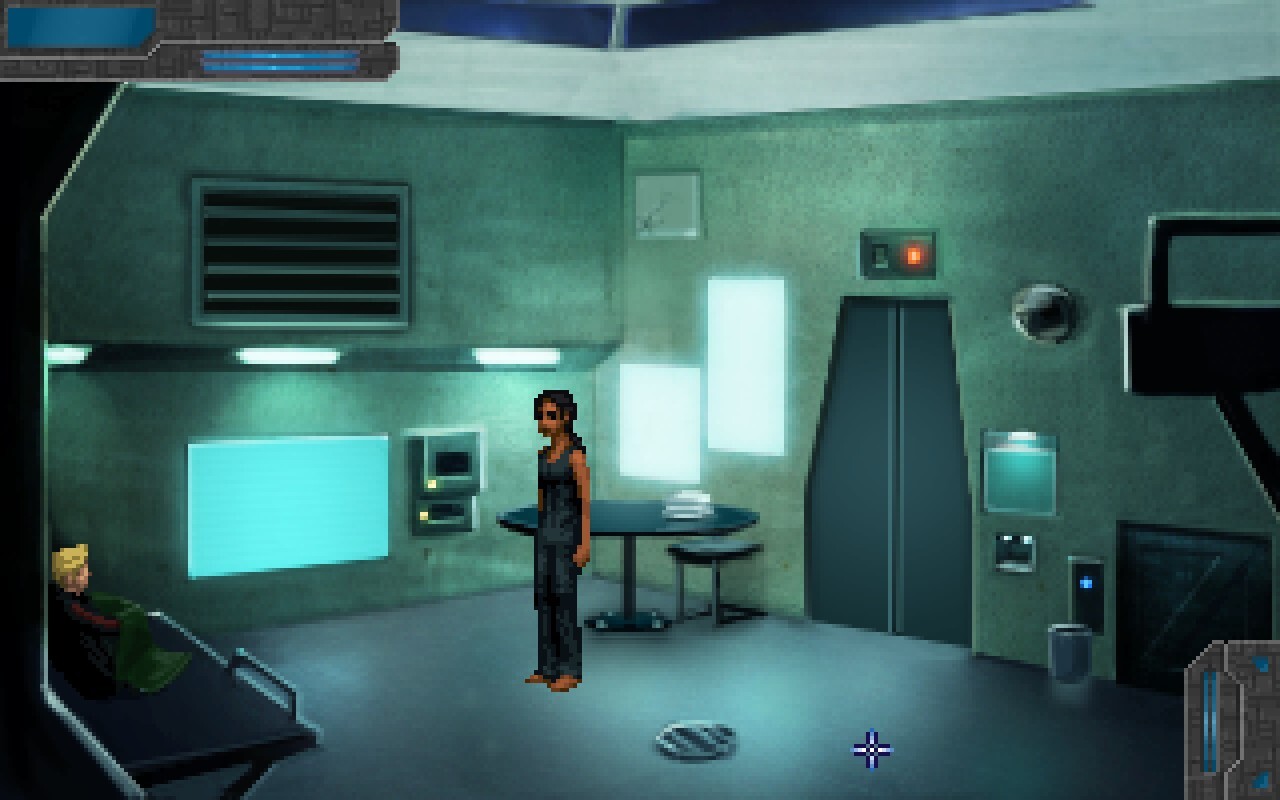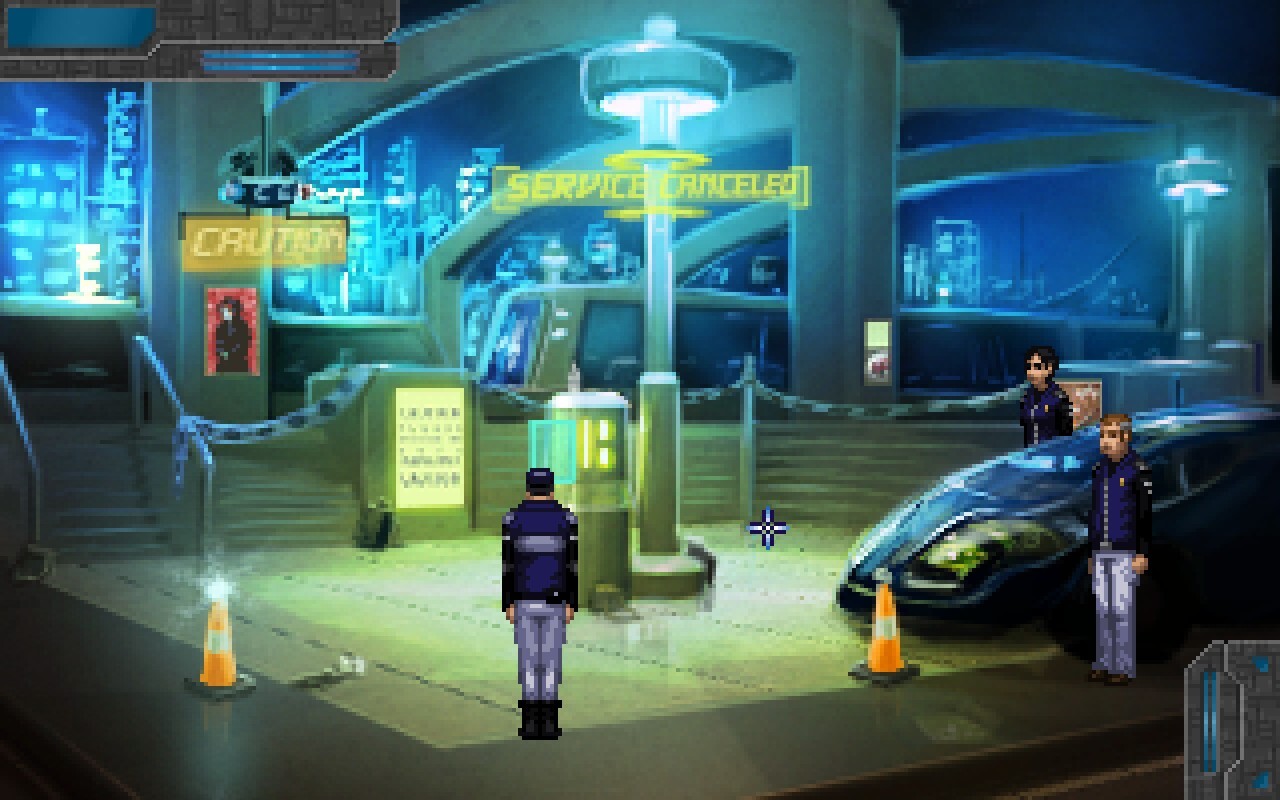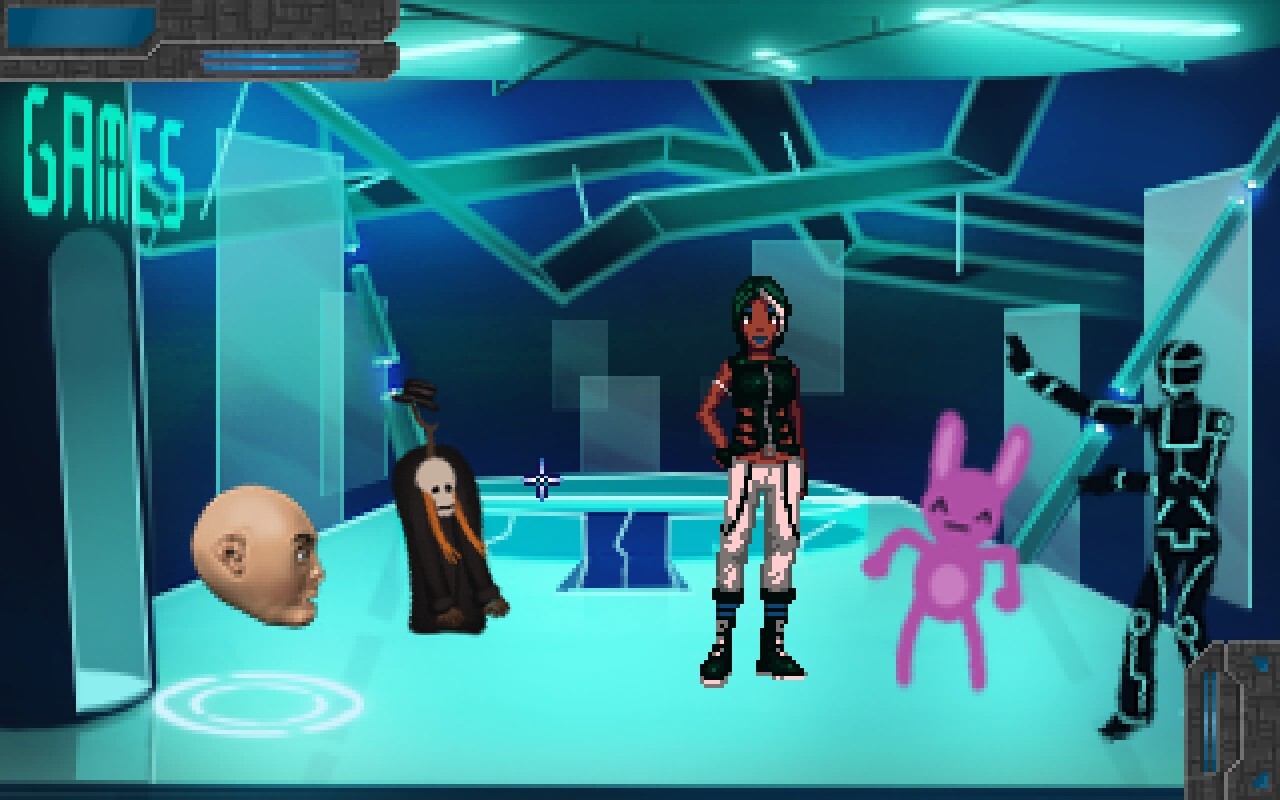I first encountered Technobabylon in 2010, in the form of an escape-the-room game called Technobablyon Part I: Prisoner of Consciousness. Being both an escape-the-room game and a part-1-of-10 game, it was pretty short, but what was there piqued my interest. My interest was further piqued by its longer, better followups, The Weight of the World and In Nuntias Veritas, both of which followed it in fairly short order – always encouraging with episodic freeware games.
And then nothing, for years. I figured the Technobabylon series had been abandoned, so imagine my surprise when it was announced that the whole series is being rolled into one big commercial game with Ben Chandler pixel art and Wadjet Eye-standard voice acting. Obviously I pretty much got right on that as soon as it was released, i.e. only let it languish in my Steam library for a brief spell of six months.1
# Story

Trapped in a room once more.
Among the first adventure games I ever encountered was Revolution Software’s Beneath a Steel Sky (free on GOG!), which has you playing Robert Foster, adopted son of a desert tribe in post-apocalyptic, cyberpunk Australia, who finds himself trapped far from home in a dirty, hostile city. While trying to escape, he encounters many expected tropes of the setting: robots, city-controlling computer systems, genetic engineering and a version of the internet you can plug your brain into and walk around in.
We find many of those same things in Technobabylon, but all of them with a very different spin. Abnormally for this kind of story, no great disruptive event (worldwide nuclear war, plague, alien invasion) has occurred in the recent past to make the entire world a dystopian hellhole, and nothing of the opposite character has happened to make the world a utopia either. Instead, Technobabylon’s setting feels like a reasonable vision of the future, extrapolated from current trends, and then painted over with a slightly dated but still stylish 80s cyberpunk aesthetic.
In Technobabylon’s 2087, most of the world’s nations have joined up in various US-style federations (though some nations, including the US itself, have split up). They have been multiple nuclear bombings around the world, but the first and third world are still largely in tact, if shuffled around a bit – notably, the entire game takes place in a city-state situated on the horn of Africa. Technology has evolved past VR helmets and onto biological brain implants called “wetware” which allow people to connect to a Snow Crash-style MMO internet called “Trance”. People also anachronistically use the 80s idea of futuristic cellphones.
The game’s actual storyline follows three different characters embroiled in a hunt for a criminal “mindjacker” – basically a futuristic serial killer who steals their victims’ minds while murdering them. There’s Lathe Sesame, a Trance-addicted young orphan raised by the city; Charlie Regis, a stubborn luddite police detective with a lot of emotional baggage; and Max Lao, Charlie’s easy-going younger partner. The game swaps between the three as appropriate, but the story mostly focuses on the first two, who are the more interesting characters anyway.
# Gameplay

People will still use VLC in the future.
I praised another Wadjet Eye game for featuring puzzles which tied into its story well and made the player feel like they were actually doing what the character would do, rather than playing the adventure game metagames of “pick up everything”, “try to read the designer’s mind” and “rub every item on every other item until something happens”. Technobabylon adds another dimension to this – it uses the puzzles as a way to explore the game’s rich sci-fi setting, mostly through messing around with cool technology, and usually in a way that forces you to think about the puzzle on its own terms rather than trying any of the previously mentioned tedious metagames.
My favourite puzzle was a delightful reoccuring one where you had to rearrange elements of AI minds. Each AI encountered in the game had personality, memory and function mind modules which could be extracted and mixed and matched in other AI minds. What made this puzzle really enjoyable was that the game provided fully voiced dialogue for all possible combinations, regardless of their relevance to solving puzzles. So you could mess around endlessly giving different robots wildly inappropriate personalities and mixing their functions and memories.
Not all of Technobabylon’s puzzles are quite perfectly integrated: there’s one particular light source puzzle which reeks of contrived adventure game object-rubbing and designer-mind-reading – you’ll know the one when you get to it. But the game mostly does a good job on this front, so one or two lousy puzzles are more than worth it for the really enjoyable ones.
The original Technobabylon episodes were intended to contain a number of minigames, at least one of which was released. Thankfully, none of these minigames are anywhere to be found in this version. Creator James Dearden’s track record attests to his love of bending the AGS engine with reaction-time-based action-puzzle games, but as with mazes in the graphical adventure game’s text-based ancestors, these sorts of things tend to be more fun to program than to play.
# Presentation

The Trance – note the more cartoon-y artstyle.
Pixel art is not everyone’s taste, but I have a soft spot for it, and Technobabylon has some really cool backgrounds. If there’s anything to complain about in the graphics department, it’s that whenever you have to read in-world text on pixelated interfaces, it’s a bit of an eyestrain – not enough to make reading a complete chore, but enough to noticeably annoy.
I mentioned in my last review of a Wadjet Eye game how pleased I was with the low-res fonts, but I’m not sure if that’s an opinion I still hold (maybe I’m getting old). The low-res fonts used for most text are not as much of a pain as in-world text, but Technobabylon is a very text-heavy game (even if you switch the dialogue to voice-only), and after a few hours they began to wear on me. Graphical incongruity aside, I would greatly have appreciated at least a toggle option to make the fonts a little bigger.
Technobabylon is the first Wadjet Eye game to have its voice acting recorded in a proper studio, and it shows. The VA in this game is a big improvement on previous games, to the point where you might want to only play this after finishing the Blackwell series, just so you don’t spoil yourself – it’s not that the previous games had bad VA work, exactly, but this one really steps things up a couple of notches.
# Conclusion
Though I loathe basing a game’s value on its hours of play, it’s worth mentioning that, as an amalgamation of what was originally to be a ten-episode series, Technobabylon is a good deal longer than, say, one of the Blackwell games. If you take your time, explore the scenery and do a commentary run afterwards,2 you can easily get 20+ hours from this game.
More importantly, those are 20+ quality hours, fulled with intricate sci-fi world-building, great character work and good puzzles. If you like point-and-click adventure games at all, this is a must-play.
 David Yates.
David Yates.
 David Yates said on
4 January 2023:
David Yates said on
4 January 2023: